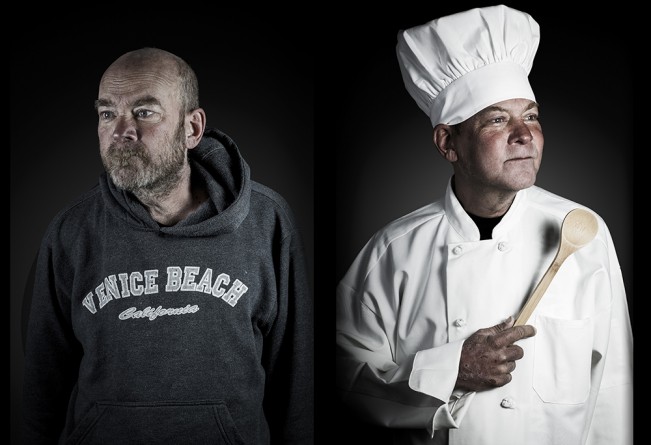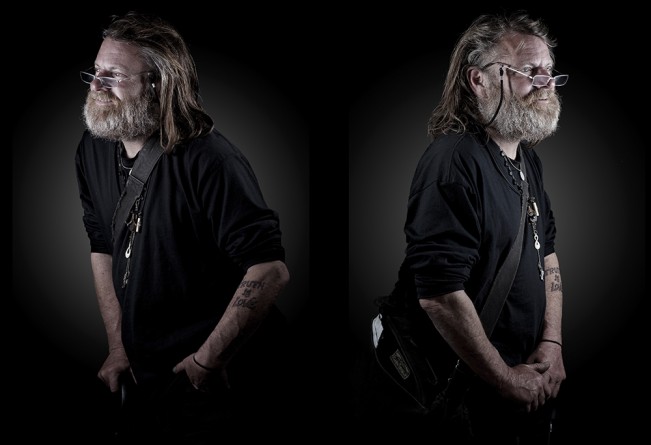Horia Manolache: The Prince and the Pauper
Long ago, during my early years in New York, Esquire Magazine created a make-over feature about homeless alcoholics. The “before” photograph revealed a down and out man clutching a paper bag with a cheap beer, the “after” was the gentleman cleaned up, hair cut, in a beautiful suit with a snifter of cognac or a martini glass of gin–needless to say, the transformation was starting. In October, I had the opportunity to see Horia Manolache’s project at the Medium Festival of Photography in San Diego, and the work brought me back to that Esquire article, but this time, the make-over was about unrealized dreams. It’s a poignant series about lost chances, a series in which Horia needed to gain the trust of homeless adults, allowing them to reveal who they might have become.
From Horia: After two years of going to a technical university I decided to drop it and to find something else to do, something to engage my imagination and to make me feel free. I had a sabbatic year in which I rediscovered my bending to image in general so I started to photograph as I felt the need to express myself and to show the world who I am. Meanwhile I took an one year photography course, I graduated a film school in Romania as a film director and now I am enrolled in a MFA program at Academy of Art University from San Francisco.
After starting the MFA program, I won the first place in the Book proposal category winner at Prix de la Photographie Paris in 2014, first place at International Photography Award in 2015 (editorial/personality ), first place at Longford Expressions Exhibition in 2015, I was nominated for the Felix Schoeller Photo Award also in 2015. My work was selected for Px3 Curators Challenge by Daphne Angles (editor at The New York Times) and to be part of Photographer’s Forum Best of Photography in 2015 book. I won a honourable mention at Rayko’s “Perimeter of the world” exhibition in 2014, several IPA awards also in 2014, my work was exhibited at Streit House Space, 4×5 Gallery, Espace Beaurepaire, Magasin de Jouets Galerie, Arles Photo Festival, PhotoPlace Gallery and it was featured, among other, in Lenscratch , Rangefinder Magazine, Forbes Life and Forbes Up. Part of my “The Prince and The Pauper” series was shown in a projection at De Young museum ( Koret Auditorium – 2015 ) as part of the history of San Francisco in photographs and five pieces of this series are exhibited at Osnanbruck Culture Museum.
The Prince and the Pauper
I came in San Francisco in 2013 and the first thing I noticed was the high number of homeless people. Photographically, it is an over exploited and in some circles, obsolete subject. Prior to my coming here I did some editorial work for Forbes and this experience made me ask myself what is the criteria for choosing a person to have their story in the magazine. A thought led to another and Mark Twain’s novel came in my mind so I imagined this idea of them changing their roles with their successful version, they as they wanted to be. During a project that I did on San Francisco’s streets, I began to be familiar with the people that I saw everyday. I began to speak with them, some of them followed the path created by the society and some created theirs but what brought them here and how would they be if everything would not have gone wrong? My project might be an answer of these questions.
It was before starting the school when I had the curiosity to explore our family’s painting albums where I found magnificent works of Rembrandt Van Rijn. Later, I remember that I’ve seen the work of Edward Weston where things aren’t what they seem to be and I had a epiphany, certain things matched in my mind. In both cases, their style gave me a sense of mystery common with the film noir. Having this two landmarks, I felt that I should isolate my subjects, so I can connect my work better with the viewer and, although I am attracted and I understand the strength of the environmental portraits, I believe people tell more with their eyes and their faces. Later on I found Jim Goldberg’s “Rich and Poor” exhibited at Pier 24 in San Francisco and seeing the contrast between the photos and the words that his subjects wrote on the photos made me realise that a photo cannot tell the truth or at least not all the truth, it just gives the photographers “truth”. As a consequence, for my project I started to record the stories of the people I photographed, I began to have a personal dialogue that gave me the context that I needed and that could not be found just in the portraits. One of my favourite portraits, “Migrant mother” of Dorothea Lange, strengthened my opinion that showing a closer copy of a person gives a greater response from the viewer and this I think because of the “Gulliverish” impression that the viewer has. You see somebody or something at an unnatural scale or from an unlikely distance. This I believe is the goal of my project, to show the homeless people in an improbable approach and from a closer distance and to question what defines the human identity.
Posts on Lenscratch may not be reproduced without the permission of the Lenscratch staff and the photographer.
Recommended
-
Nathan Bolton in Conversation with Douglas BreaultJanuary 3rd, 2026
-
Salua Ares: Absense as FormNovember 29th, 2025
-
Ricardo Miguel Hernández: When the memory turns to dust and Beyond PainNovember 28th, 2025
-
Pamela Landau Connolly: Columbus DriveNovember 26th, 2025







































































